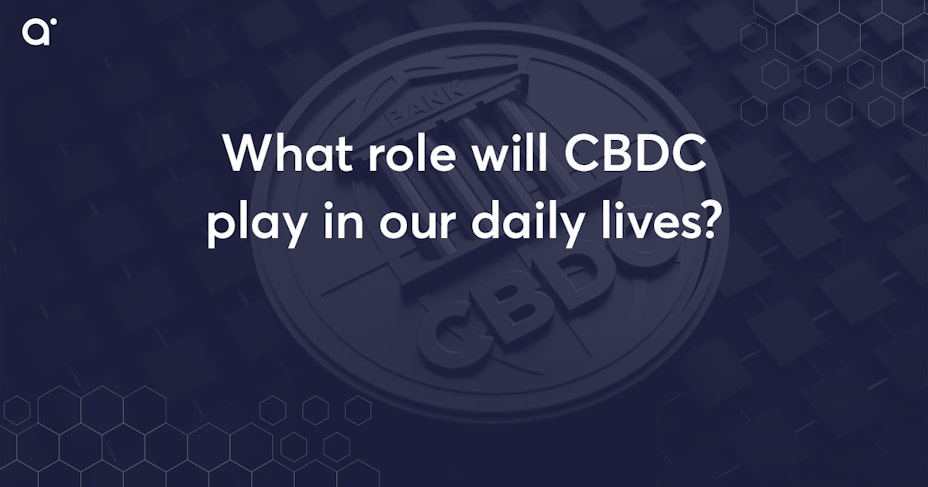What role will CBDC play in our daily lives?
- 15 minute read

The answer to this question is so multifaceted that I wrote this blog article about it to give you an idea of what CBDC can mean in our daily lives. There is a downright hype about CBDC going on on social media. We will talk about that too. Usually the soup is not eaten as hot as it is served. So let's dive right in!

What is CBDC?
CBDC is an abbreviation for Central Bank Digital Currency. So if you explain this in simple terms, this is digital money issued by national central banks.
Of course, we are going to tell you much more about it, but this way you already have a small idea of what it is.
Summary:
- CBDC is digital money from central banks
- CBDC exists in various forms for citizens, businesses and financial institutions, and is implemented worldwide
- Benefits of CBDC include improved privacy and accessibility, with concerns about centralization and privacy
- CBDC can bring significant changes to both society and the financial system
- The integration of CBDC into everyday life is expected to proceed like the move to debit card payments
Table of content
- What is CBDC?
- The history of CBDC
- The import of paying with your PIN
- Types of CBDC for central banks and commercial banks
- What is CBDC part two
- Benefits of CBDC
- Disadvantages of CBDC
- Which countries already have CBDC for monetary policy?
- Criticism of CBDC and central banks
- What role will CBDC play in our daily lives?
The history of CBDC

Although most people have only known about CBDC for a few years, the concept is much older. Central banks have been exploring the possibilities of a CBDC for decades.
Finland's central bank already issued an e-money card in the 1990s.
In 2014, China's central bank began exploring the idea of a CBDC.
Ecuador's central bank had a mobile payment system from 2014 to 2018.
In 2019, Facebook announced their intention to release a global digital currency: the Libra. It is more than likely that central banks realized they could not miss the boat. This kind of digital currency could threaten the conduct of monetary policy by national central banks. Since then, you regularly hear about the digital euro and CBDC.
In 2020, the ECB published a report on the introduction of a digital euro in countries that had the euro as a means of payment. It looked at how this could work from different perspectives. The issuance, control and transmission of CBDC is not easy. It looked at whether this could be done through smart contracts on a blockchain could or that there were other plausible possibilities.
In 2021, a lot of research was done mainly by the ECB. No obstacles were found.
The ECB announced in 2022 a collaboration with a number of companies, including Amazon and CaixaBank, to develop interfaces to use CBDC. Christine Lagarde, president of the ECB, said CBDC need not be limited to payments, but has the potential to affect all of society.
Further research followed in 2023, looking at a rulebook for the digital euro. The European Commission then proposed its plans. Both the European Council and the European Parliament would have to judge whether to agree on any introduction.
The first major economy to accept a CBDC was China, which launched the digital Renminbi.
The import of paying with your PIN
This is a little philosophical consideration before you continue reading. There has been much talk about the introduction of debit cards. It would replace cash and the government and banks would know everything about you (except your PIN) and could also use it against you.
Older people and digibits swore by cash and old socks.
It would also become virtually impossible to become a criminal anymore. Too bad for those with that ambition.
The totalitarian state was right around the corner. However, it is still there. And criminals still know how to find the holes in the financial system to continue their careers.
It is more than likely that CBDC will follow a similar career path.
Types of CBDC for central banks and commercial banks
- Retail CBDC: this is a payment system for citizens and businesses to make payments.
- Wholesale CBDC: these are designed for financial institutions such as banks and are somewhat similar to the reserves of a central bank.
- Hybrid form, with the central bank taking on Retail CBDC and the financials Wholesale CBDC.
What is CBDC part two
Now that you know a little bit about what CBDC is, we'll look at it in a bit more detail so you can get the full picture.
Central Bank Digital Currency is fiat money , issued by a central bank and thus a legal tender. This means you must accept this money in an exchange, such as in a store.
One of the main differences between CBDC and today's fiat money is that it is issued by a central bank and thus is actually public money and not private money, as created by a commercial bank.
The problem with commercial banks issuing fiat money is that they can go bankrupt due to poor management. Moreover, they operate with fractional reserves, which can expose them to a bank run, as with DSB bank. This can happen quickly, as we saw in the 2008 financial crisis.
On top of that, a number of banks are too big to fail. By this is meant that they are so big that if they fail there is far too great a risk to society and they do have to be rescued must become. This gives them an unfair advantage because they can take hefty risks, since they will be saved anyway if things go wrong.
This boils down to the following: they take huge risks and most of the time it goes well. In that case, they make huge profits. When it goes wrong they make society pay for it. Of course, this is not a working concept unless you are such a bank.
When central banks issue fiat money, the situation is different. The central bank does not do fractional banking and has 100% on hand at all times. This prevents bank runs and it is therefore a very veillig system, where monetary stability is paramount. Moreover, there is no need to create money with money, because central banks are almost all publicly owned, except in Belgium (50%), Switzerland and the US.
Most forms of CBDC will not use a distributed ledger, as with blockchain. The most likely is that governments or approved agencies or companies will maintain a database of everyone's funds, where privacy will be guaranteed by cryptography . Although the inspiration (and fear of, say, the Libra) for CBDC lay with cryptocurrency technology will be centralized.
The digital euro will not become programmable money . This is digital money that can only be used for certain purposes, has an expiration date or can otherwise be steering.
Since countries that collectively achieve 95% of global GDP are in the process of exploring or implementing a CBDC, it seems to me that it is inevitable that this will happen. How, that remains to be seen.
CBDC will be a digital instrument with very high security. It will probably be a lot more secure than banknotes, no matter how difficult they are to counterfeit. You cannot counterfeit a CBDC at all, if all is well.
CBDC will have major implications for commercial banks, which will see their commissions and profit opportunities restricted. Selling customer data will also be severely limited or impossible.
Benefits of CBDC

- Privacy. Although this is a dubious case, the idea is that only the two parties in a payment know who they are. Payments would be completely anonymous. However, this seems to me to depend on who the governing political parties are.
- Every legal citizen has access to safe and cheap money and cannot be excluded from a bank account. Even without a bank account you should be able to pay with a digital euro.
- Convenience. The purpose of CBDC is to reduce the technicalities of working with money. In other words, it should be even easier than working with a traditional bank account, specifically to get everyone involved.
- Vulnerable groups are helped to work with the digital euro. The mentally disabled, people who do not speak the language or other vulnerable groups are given the opportunity to consult someone free of charge to help them set up and spend the digital euro.
- Prevention. Since the central bank knows exactly who has what, it is easier to tax people who are now engaged in tax evasion. Money laundering, illegal transactions and other criminal activities also become much more difficult. Moreover, you can reverse transactions in a case of fraud, which is a huge benefit for consumers.
- Retailers have lower costs for payment transactions, which can make products cheaper.
- Proof of Transaction. Because there is a digital file containing the transaction, convenient cash tricks have become impossible.
- Money becomes a public commodity.
- CBDC is safe money in free bank accounts and will be stiff competition for private banks, requiring them to behave very well or they will fall by the wayside.
- An additional option for holding money in addition to your bank account and cash.
- Big money providers that charge hefty commissions are effectively shut out. Visa, Mastercard, American Express, PayPal and the like will attract few more customers. Far too expensive.
- Monetary tools. For example, a central bank can hand out helicopter money (giving everyone a certain amount for free) or a basic income, knowing exactly who this money will end up with. Currently, the European Central Bank works with instruments that are difficult to predict, such as Quantitative Easing , which ends up mostly with the rich. Changing the interest rate is also a difficult tool to fathom and does not work precisely enough. Inflation can be regulated at the push of a button, which can encourage people to spend money, thus stimulating the economy. A full reserve banking system can produce a much more predictable economy that is not dependent on commercial parties. Bank runs and a deposit guarantee system will soon be a relic of the past. Financial stability will no longer be dependent on a third party if it is implemented.
- Technological efficiency. Because payments are instantaneous, sellers no longer have risk. It is directly in their account. So payments become cheaper and less complex. Transaction costs can be reduced or eliminated for things that now require, say, credit cards or the like.
Disadvantages of CBDC

- Problems with commercial banks on introduction. If such safe and free money is introduced, many people will take their money away from commercial banks. This may cause bank runs in the beginning. Possible solution to this is maximum amounts of CBDC you are allowed to have. This is a very weak point in the introduction, where the government has already indicated that there will be a cap on the number of digital euros you are allowed to hold, so you are still stuck with commercial banks.
- Centralization. Whoever manages the money supply can add or remove money from anyone's account at the touch of a button. There should of course be a brake on this, as is common with cryptocurrency.
- Cyber attacks and hacking on digital currency.
- If there is a country with a very strong digital currency it can become a substitute for local currencies. If a trader in any country other than the U.S. wants digital dollars for their products, it can largely replace the local currency. A very large portion of international trade is done with dollars. That is a solid reliance on the currency of only one country.
- Privacy. Digital money gives a government the opportunity to control the people and watch what we spend all our money on. This can lead to self-censorship and loss of freedom of expression. If the government is watching and God knows who else, you might buy less alcohol or something. This doesn't feel good.
- Social manipulation. You can turn it into a kind of 1984 and get Orwellian states. Dissidents can face empty wallets and worse measures. Money should only be spent on things central banks want. With CBDC you can direct the people to spend it on desirable things and determine in what time frame.
- Administrators, elected or not, decide whether CBDC will be there or not. The people lack a democratic perspective.
Which countries already have CBDC for monetary policy?
In the Caribbean, nine countries and eight islands, part of the Eastern Caribbean Currency Union, have introduced CBDC.
38 countries and Hong Kong are working with pilot programs.
67 countries and 2 currency unions are exploring CBDC to see when and if they will introduce it, including the EU.
A number of countries have launched their own cryptocurrency, such as the Petro in Venezuela and the Sovereign in the Marshall Islands. Some states are also trying to circumvent international sanctions with their own kind of CBDC or cryptocurrency.
Criticism of CBDC and central banks
The big question: do you trust a commercial party more than the government? Now that has actually become a very difficult question. Commercial parties want your money, that's obvious. They want to maximize profits. Can you trust these parties? Well, as long as you can see and hear them, so to speak. Or as long as you don't have to pay anything yet. If you do, then suspicion is in order.
Well, then we'll just look to the government, the protector of the weak, right? There's something to be said about that in recent years, too. After a number of major affairs in which the government and politicians have shown their worst side, suspicion of government and politics is beginning to grow. Perhaps this is partly justified.
Now the same politics and government wants to introduce digital money into the market. It is not surprising if people are suspicious then. They will then grab the list of disadvantages rather than the advantages, which are enormous after all.
There is a real craze on social media about CBDC. If you have the audacity to mention CBDC anywhere you are still talking about that topic months later. Those who are against CBDC are quickly called a wappie, these are conspiracy thinkers. The people who call another wappie call themselves snappies, people who understand how the world works.
The so-called wappies call the snappies slappies, these are people with no backbone who always follow the government-narrative. What also happens is that they are called nappies by the wokies, those who are still asleep versus those who are awake.
Trump, too, of course, is joining this craze. In a statement on X is a solid position from him on this.
This polarization has become a very complex problem for society as a whole, causing the introduction of just about everything from CBDC to a new pension system to be viewed with great suspicion, especially by people who benefit little from the system.
My own position on CBDC is hopefully rather sober: you can't afford much with something like fiat money. It is too big to derail. If you go wrong as a politician or government with the money supply you risk violent reactions from the people. You really can't derail that train, so mainly the benefits will emerge from the list.
What role will CBDC play in our daily lives?

Before I answer this question, I will ask another question. What role has pins played in our daily lives?
You used to go to the store and you had to pay cash everywhere. If you went to buy an expensive product, you walked around with a lot of money in your pocket. This was quite a risk.
With the advent of debit card payments, there was virtually no need to carry cash. If a robber could get his hands on 50 euros he pretty much hit the jackpot.
From the other side, the introduction of PINs hardly affected our daily lives. It went silently, so to speak, outside of a few elderly people saying, as usual, "Where is the world going? If only everything stayed the golden old days."
My prediction is that things will be no different at CBDC. The advantages will greatly outweigh the disadvantages.
Payment transactions will become easier and cheaper. Commercial banks will have to offer many more and cheaper services if they still want to stay in the market. Retailers will have lower payment costs and products may become cheaper.
The difference with debit cards is minimal. Whether paying with a debit card using fiat money or CBDC is redeemable.
People will quickly get used to CBDC and it will quickly become established, just like debit cards. Older people will say, "Where is the world going? If only everything stayed the golden old days."
Criminals and terrorists will have fewer opportunities to hide or spend their capital. This will increase global security.
Banks will no longer fail. Fiat money will become much more reliable and largely in public hands. There will be a possibility of handing out helicopter money, instead of indirect stimulation of the economy, where the money goes first primarily to the rich.
In the run-up to the introduction, there will be many conspiracy theories put forth. After implementation, it will be seen that none of them have (hopefully) proven true.
We don't live in a totalitarian society. Whatever you may think of politics, you can generally just walk around, say what you want, buy what you want and vote for who you want. CBDC will not be programmable because that would be too much of an infringement on freedom. Programmable digital money is meant to prohibit certain purchases and encourage others. There will also be no end date on when you have to have it spent, if all goes well. They could do this to stimulate the economy.
Actually, the introduction of a CBDC will probably be quite silent. Once we get used to this new form of payment and storage, it will be as if it has never been any different. With the exception of people who reject all new technology. They still pay everything in cash and want to handle everything on paper. But then again, you always have such people everywhere.
So CBDC is not going to play a major role in our daily lives at all. It will only be a temporary bump on the bumper.


